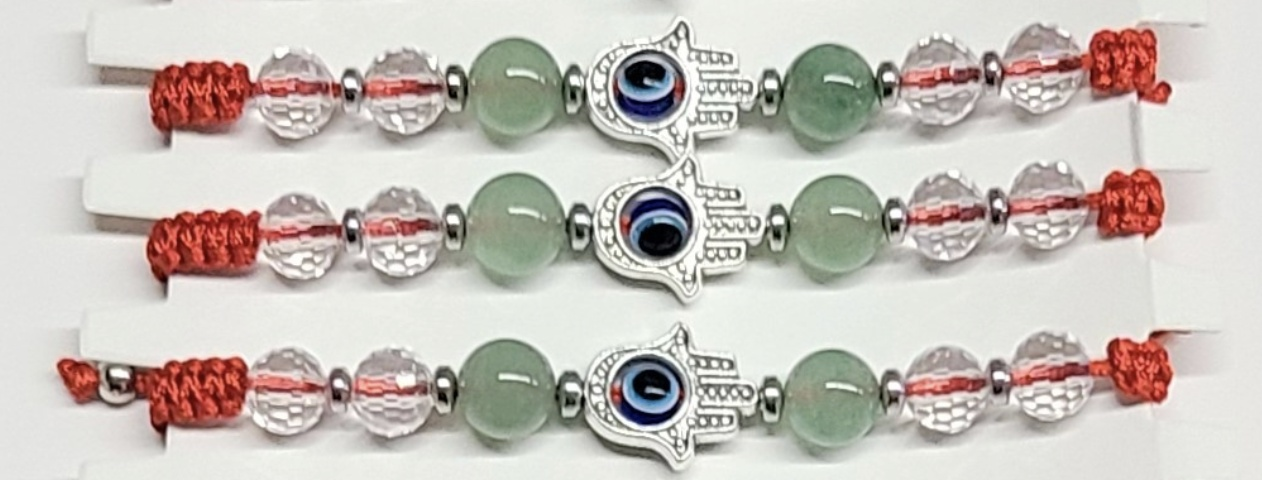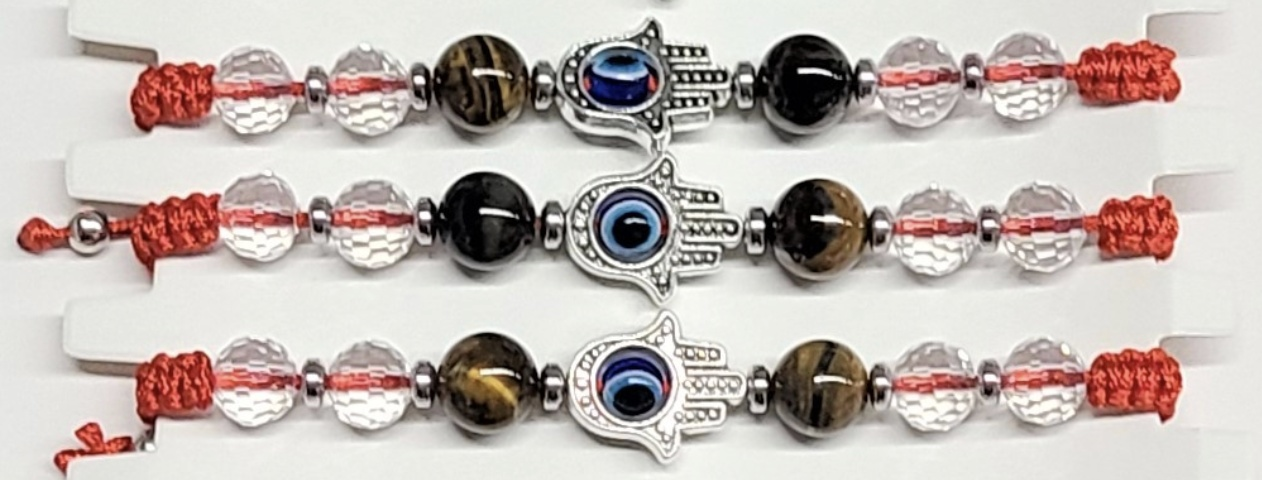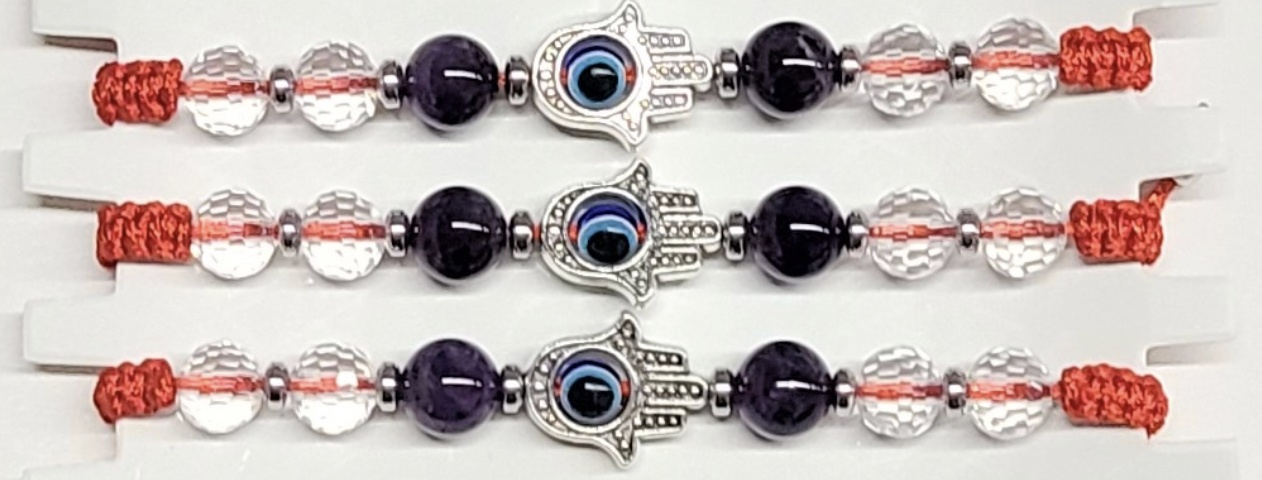



Red String Hamsa Crystal Bracelet
You will receive 1 bracelet of your choice. Pictures to show options.
The Hamsa Hand, also known as the Hand of Fatima or Hand of Miriam, is a powerful symbol with deep spiritual and cultural significance across various traditions. This amulet is recognized for its protective properties and is believed to bring good fortune, happiness, and health. It is typically depicted as an open right hand, sometimes with an eye in the center, and can be found in jewelry, wall hangings, and other decorative items.
Historical and Cultural Context
-
Middle Eastern and North African Traditions:
- Islam: In Islamic culture, the Hamsa Hand is known as the Hand of Fatima, named after Fatima Zahra, the daughter of Prophet Muhammad. It symbolizes patience, loyalty, faith, and resistance against difficulties. The five fingers are often associated with the Five Pillars of Islam.
- Judaism: In Jewish tradition, the Hamsa is referred to as the Hand of Miriam, named after Miriam, the sister of Moses and Aaron. It is a protective symbol meant to ward off the evil eye (ayin hara) and is often associated with the number five, representing the Five Books of the Torah.
- Christianity: Though less common, some Christian communities in the Middle East and North Africa also use the Hamsa Hand as a protective amulet, sometimes incorporating crosses into its design.
-
Indian Subcontinent:
- In Hindu and Buddhist cultures, the open hand is a common motif representing protection, blessings, and the dispelling of fear. The Hamsa is sometimes associated with the gesture of the Abhaya Mudra, a hand position symbolizing fearlessness and protection.
-
Western Adoption:
- In contemporary Western societies, the Hamsa Hand has been embraced as a universal symbol of protection and good fortune. It is popular in jewelry and home decor, often appreciated for its aesthetic appeal and perceived metaphysical properties.
Metaphysical Properties and Symbolism
-
Protection:
- The primary metaphysical property of the Hamsa Hand is protection against the evil eye and negative energies. The open hand is thought to repel harm and provide a shield of defense around the wearer or the home.
-
Blessings and Good Fortune:
- Beyond protection, the Hamsa Hand is believed to attract blessings, prosperity, and good fortune. Its presence is thought to invite positive energies and opportunities into one's life.
-
Spiritual Awareness:
- The eye, often depicted in the center of the Hamsa Hand, symbolizes divine watchfulness and spiritual awareness. It serves as a reminder to stay mindful and connected to one's higher self and spiritual path.
-
Unity and Harmony:
- The Hamsa Hand also represents the unity of various faiths and cultures, symbolizing the shared human desire for protection, peace, and prosperity. It serves as a bridge between different spiritual traditions, emphasizing common values and beliefs.
-
Feminine Power and Strength:
- In many traditions, the Hamsa Hand is associated with feminine energy and attributes such as compassion, nurturing, and strength. It honors powerful female figures like Fatima Zahra and Miriam, celebrating their virtues and protective qualities.
Cultural Variations and Interpretations
-
Design Elements:
- Five Fingers: The five fingers of the Hamsa Hand often represent the five senses or the five elements, encouraging balance and harmony in one's life.
- Eye Symbol: The eye in the center is a potent symbol against the evil eye, known in various cultures as the Nazar, which protects against jealousy and malevolent stares.
- Fish Motif: In some Jewish Hamsa designs, fish motifs are incorporated, as fish are believed to be immune to the evil eye.
-
Colors and Materials:
- The Hamsa Hand is crafted in various materials and colors, each adding a layer of meaning. Blue is a common color associated with protection and healing, while gold signifies prosperity and abundance. Silver is often used for its reflective properties, symbolizing purity and clarity.
-
Modern Interpretations:
- Today, the Hamsa Hand is often stylized to fit modern aesthetics while retaining its traditional meanings. It is a popular motif in contemporary jewelry, fashion, and interior design, bridging ancient symbolism with modern spirituality.
Practical Applications
-
Jewelry:
- Wearing Hamsa Hand jewelry, such as necklaces, bracelets, or rings, is a common way to carry its protective and auspicious energies. It serves as a personal amulet, providing a sense of safety and well-being.
-
Home Decor:
- Placing Hamsa Hand decor in homes, such as wall hangings or decorative tiles, is believed to protect the household from negative influences and create a harmonious living environment.
-
Meditation and Rituals:
- Incorporating the Hamsa Hand into meditation practices or spiritual rituals can enhance one's focus and connection to protective energies. It can be used as a focal point to visualize the dispelling of negativity and the attraction of positive forces.
-
Gifts:
- The Hamsa Hand makes a thoughtful and meaningful gift, symbolizing good wishes and protection for the recipient. It is often given on special occasions such as housewarmings, weddings, or births.
In summary, the Hamsa Hand is a rich and multifaceted symbol that transcends cultural boundaries, offering protection, blessings, and spiritual awareness to those who embrace it. Its enduring appeal lies in its ability to unite diverse traditions and convey universal values of peace, prosperity, and well-being.
The Evil Eye is a concept that transcends cultures and epochs, representing a powerful symbol of protection against malevolent forces. Its origins trace back thousands of years, permeating various cultures and belief systems around the world. This expanded description delves into the cultural diversity and metaphysical properties of the Evil Eye, excluding health-related topics, to provide a comprehensive understanding of its significance and applications.
Historical and Cultural Background
-
Ancient Mesopotamia: The concept of the Evil Eye first appeared in ancient Mesopotamia around 3,000 BC. It was believed that the malevolent glare of the Evil Eye could bring misfortune, injury, or bad luck to the person at whom it was directed. Amulets and talismans were crafted to protect individuals from these harmful influences.
-
Ancient Greece and Rome: In ancient Greece and Rome, the Evil Eye was a well-known phenomenon. Greeks referred to it as "baskania," and Romans called it "oculus malus." They believed that envy and jealousy could project negative energy through one's gaze. Protective charms, such as the "Nazar" in Greece, were used to ward off this malevolent force.
-
Middle Eastern Traditions: The Evil Eye is a significant element in Middle Eastern cultures, particularly within Islamic traditions. Known as "Ayn al-Hasad" or "Nazar," it is believed that the envious look can cause harm. Blue glass beads, often with an eye motif, are popular protective amulets in this region.
-
Jewish Folklore: In Jewish culture, the Evil Eye is referred to as "Ayin Hara." Protective measures include the use of hamsas (hand-shaped amulets) and red string bracelets, which are tied around the wrist to absorb negative energy.
-
South Asian Beliefs: In South Asia, particularly in India, the Evil Eye is known as "Nazar" or "Drishti." Various rituals and talismans, including lemon-chili hangings and black kohl, are used to protect against its effects.
-
Latin American Traditions: In Latin America, the Evil Eye is called "Mal de Ojo." It is believed that infants and young children are particularly susceptible. Protective practices include wearing red bracelets and using special charms.
Metaphysical Properties and Uses
-
Protection: The primary metaphysical property of the Evil Eye is protection. It is believed to safeguard individuals from negative energies, envy, and harm. Amulets featuring the Evil Eye symbol are commonly worn or displayed to create a protective barrier around the wearer.
-
Deflection of Negative Energy: The Evil Eye amulet is thought to reflect negative energy back to the source. This deflection prevents the harmful intentions from affecting the intended target, ensuring that the wearer remains safe and secure.
-
Balancing Energies: The symbol of the Evil Eye is also used to balance energies. It is believed to neutralize imbalances caused by negative emotions such as envy and jealousy. This equilibrium promotes a harmonious environment and personal well-being.
-
Spiritual Awareness: Wearing or meditating with the Evil Eye can enhance spiritual awareness and insight. It serves as a reminder to remain mindful of one's surroundings and the intentions of others, fostering a heightened sense of intuition and protection.
-
Symbol of Vigilance: The image of an eye represents constant vigilance. By wearing the Evil Eye, individuals are reminded to stay alert and aware of potential threats, both physical and metaphysical.
Cultural Interpretations and Practices
-
Greek Traditions: In Greece, the Evil Eye is often depicted in blue and white, symbolizing the purity and clarity needed to ward off evil. It is commonly found in jewelry, home decor, and as part of religious rituals.
-
Turkish Practices: The "Nazar Boncuk," a blue bead with an eye motif, is a ubiquitous symbol in Turkey. It is used in various forms, from keychains to wall hangings, and is believed to protect against jealousy and bring good fortune.
-
Islamic Culture: The Evil Eye is addressed in Islamic teachings, and protective phrases from the Quran, such as "Masha'Allah" (God has willed it), are used to prevent envy. Amulets with these phrases are often carried or displayed.
-
Jewish Customs: The hamsa, also known as the Hand of Fatima or Hand of Miriam, is a prominent symbol in Jewish culture. It is believed to offer protection and bring blessings, power, and strength.
-
Indian Rituals: In India, various rituals are performed to ward off the Evil Eye, such as burning camphor or using specific mantras. Charms and amulets featuring symbols like the "Nazar Battu" are also popular.
-
Latin American Remedies: In Latin America, traditional healers (curanderos) may perform rituals to cleanse individuals of the Evil Eye. These rituals often involve the use of herbs, eggs, and prayers to remove negative energy.
Conclusion
The Evil Eye is a profound symbol of protection and spiritual vigilance, deeply rooted in the cultural and metaphysical traditions of many societies. Its enduring presence across diverse cultures underscores its universal significance in guarding against negative energies and promoting harmony. By understanding its rich history and varied interpretations, one can appreciate the profound role it plays in the metaphysical realm and its continued relevance in modern spiritual practices.
Red String Bracelet
Embrace the protective and auspicious power of the red string bracelet, a symbol deeply rooted in various cultural traditions worldwide. This simple yet powerful accessory carries a rich tapestry of meanings across different cultures, each attributing their unique blessings and beliefs to its wear.
In Jewish Kabbalistic tradition, the red string is worn to ward off the evil eye and attract good fortune. Traditionally, it is tied on the left wrist, the receiving side of the body and soul, often blessed with prayers and worn as a shield against negative energies.
In Hinduism, the red string, known as "Kalava" or "Mauli," is tied during religious ceremonies to signify commitment, protection, and divine blessings. It is commonly seen during rituals and worn by both men and women as a sacred thread invoking the presence and protection of the gods.
In Buddhist practices, especially within Tibetan Buddhism, the red string bracelet is a token of protection and good luck. It is often tied during a ceremony or blessing by a monk, symbolizing the interconnectedness of all beings and the safeguarding of the wearer’s spiritual path.
Chinese culture holds the red string as a symbol of the “red thread of fate,” believed to connect those destined to meet regardless of time, place, or circumstances. This thread may stretch or tangle, but it will never break, symbolizing the power of fate and destiny in uniting loved ones.
Additionally, in Latin American cultures, the red string is known as "Mal de Ojo" bracelet and is used to protect infants and children from the evil eye. It is often adorned with small charms or beads, believed to enhance its protective properties and ensure the well-being of the young.
Our red string bracelet is handcrafted with love and intention, woven to carry these multifaceted blessings from across the world. Whether you wear it for protection, luck, or as a reminder of your connection to the universe, this bracelet serves as a constant companion on your journey through life.
-
Rose Quartz:
- Description: Known as the stone of unconditional love.
- Metaphysical Properties: Rose Quartz is believed to promote love, self-love, friendship, deep inner healing, and feelings of peace. It is also said to help restore trust and harmony in relationships, encouraging unconditional love.
-
Green Aventurine:
- Description: Often referred to as the stone of opportunity.
- Metaphysical Properties: Green Aventurine is thought to be the luckiest of all crystals, especially in manifesting prosperity and wealth. It releases old patterns, habits, and disappointments so new growth can take place. It brings optimism and a zest for life, allowing one to move forward with confidence and embrace change.
-
Tiger Eye:
- Description: Known for its golden to red-brown color and silky luster.
- Metaphysical Properties: Tiger Eye is said to help release fear and anxiety and aid harmony and balance. It stimulates taking action and helps make decisions with discernment and understanding, unclouded by emotions.
-
Amethyst:
- Description: Recognized for its beautiful violet hue.
- Metaphysical Properties: Amethyst is believed to be a powerful and protective stone. It guards against psychic attack, transmuting the energy into love and protecting the wearer from all types of harm, including geopathic or electromagnetic stress and ill wishes from others. Amethyst is also said to relieve stress and strain, soothe irritability, balance mood swings, dispel anger, rage, fear, and anxiety.



